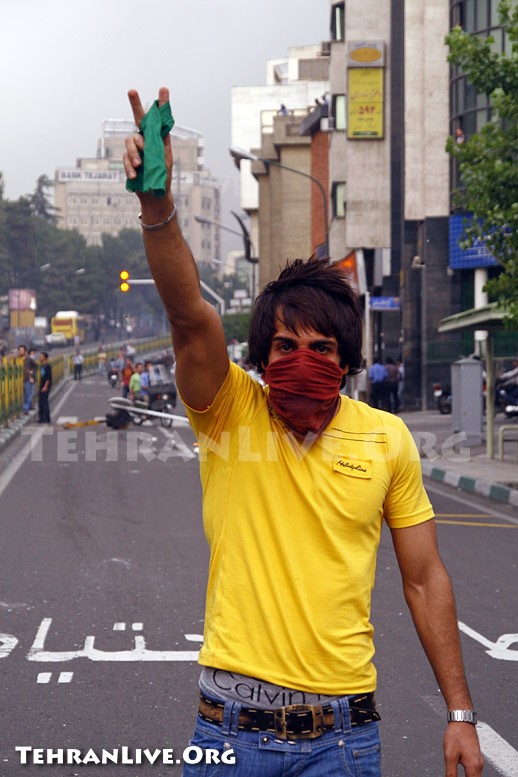Background on Iran presidential elections that have led to protests

I thought including a few excerpts with some background on the protests currently going on in Iran may be helpful to some readers. Feel free to comment with more resources and links, and I will update this post with info periodically as I find it.
Hours after polls closed in a hard fought election in Iran, both President Mahmoud Ahmadinejad and moderate rival Mir Hossein Mousavi claimed victory.
Mousavi, Ahmedinejad both claim victory, following overwhelming voter turnout.
“I am the definite winner of this presidential election,” Mousavi said at a news conference in Tehran. Mousavi’s supporters say the former prime minister was taking the “upper hand” and was expected to win two-thirds of the vote.
Mousavi’s election would be a huge upset victory. Just weeks ago, Admadinejad was expected to cruise to reelection.
While Mousavi declared victory, Iran’s state-run media declared Ahmadinejad the winner. According to Iran’s state-run TV, Ahmadinejad had garnered 68.8 percent and Mousavi 28.8 percent of the 10 million votes counted thus far.
Mousavi and other candidates have alleged voting fraud and while there is no concrete data backing Mousavi’s claims of a victory, the candidate and his aides made it clear that if official numbers do not show him to be victorious, they will fight them…
…Many locations extended voting hours to accommodate the throngs of people. Iran’s news agency reported that more than 70 percent of Iranians who are eligible to vote participated in Friday’s election.
Long lines wrapped around nearly every polling center ABC News visited, revealing a deep interest in this election, which has pitted current Ahmadinejad against popular reformist candidate Mousavi.
The month leading up to Iran’s 10th presidential election was filled with a rare show of democratic energy — heated public debates, mass demonstrations and rowdy rallies in streets around the country.
President Obama said today that he is “excited” about the “robust debate” taking place in Iran, and that it shows change is possible…
…The draw of the election — which the world is watching closely — is so powerful that even some expatriates have returned to the country to cast their ballots.
Ibrahim, an Iranian-American who declined to give his full name, flew from California to Tehran to vote for a change in foreign policy.
“We would like to have common goals between United States and European countries,” he told ABC News. (source: ABC World News)

For Iran’s young people, it’s about a wide variety of issues, everything from high inflation and rising unemployment to the social and religious climate to better relations with the West. The involvement of Iran’s young — nearly one-third of the voters are estimated to be 30 years old or younger — means that stakes are high for the presidential candidates. In the past, much of Iran’s young population has boycotted past elections, but for the first time, many young Iranians believe they can make a difference.
Clashes broke out between police and groups protesting the election results from early morning on Saturday onward. Initially, the protests were largely peaceful. However, as time passed, they became increasingly violent. Some protesters began to get violent after the results of the election were announced. Angry crowds in Tehran broke into shops, tore down signs and smashed windows. [1] The worst civil unrest in Iran for over a decade took place as protesters set fire to tires outside the Interior Ministry building and others formed a human chain of around 300 people to close off a major Tehran street.
However by June 14 the protests had grown considerably and took a much more violent turn. Cars were being parked in the middle of the streets and highways in Tehran, and the highways leading to the city, blocking traffic heavily along with burning buses and trash cans. Protestors started attacking shops, government offices, police stations, police vehicles, gas stations and banks. Large protests which escalated into riots had also broken out at Tehran University, Amirkabir University, and Shahid Beheshti University where students started burning and destroying various buildings and items around the campuses. Valiasr Street was completely crowded by protesters and young students attacking policemen and IRGC officials. The police had installed a barricade around Mehrabad Airport and Imam Khomeini International Airport fearing that the protesters were planning to attack them and had also blocked all streets leading to the Interior Ministry, where protesters were burning tires outside of the building, and were throwing rocks and Molotov cocktails. (source: wapedia.mobi)
In an attempt to quell the protests, many internet sites have been blocked, especially any social networking sites such as Facebook, YouTube, Twitter, foreign broadcasting websites, and reformist websites as well. Text and SMS, and international calls from Tehran were blocked, and by late Sunday, the cell phone services had been shut down. (source: wapedia.mobi)
ADDITIONAL RESOURCES
Times Labs Blog– IRANIAN ELECTION RESULTS BY REGION (includes bar graph and color coded map of election results)
Boston.com: The Big Picture– IRAN’S DISPUTED ELECTION
Huffington Post: Nico Pitney’s Live Blog– IRAN ELECTION LIVE-BLOGGING (first entry Sunday, June 14, continues from there)
